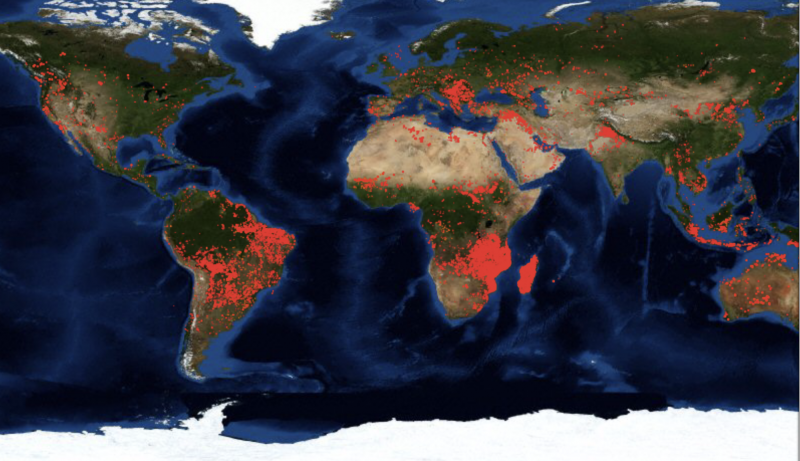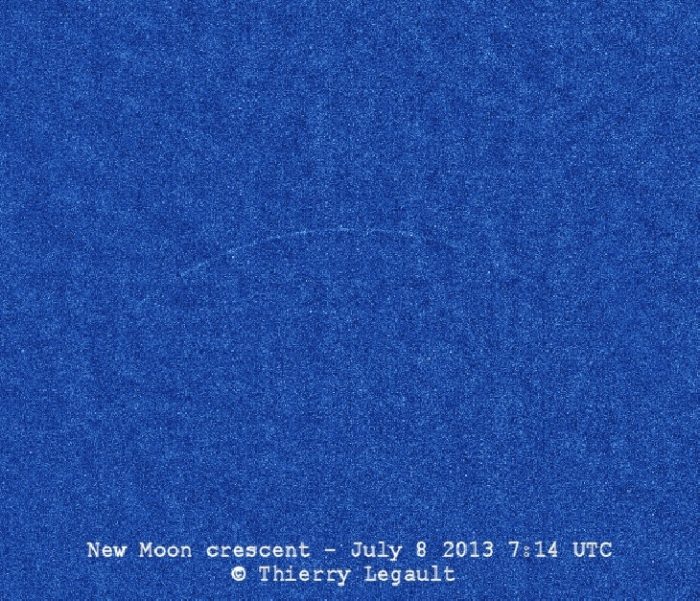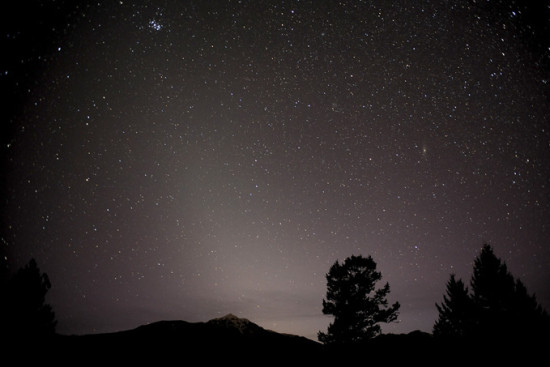

New image from China’s Yutu-2 rover, showing the bright specks of material resembling impact glass in the center of a small crater on the moon. Formerly, Chinese media were reporting this substance as “gel-like.” This image is the enhanced, high-contrast version, showing the bright specks in some detail. For the unenhanced image, see below. Image via CNSA/ CLEP/ Space.com.
Last July, China’s Yutu-2 rover discovered something with an unexpected color and luster during its travels on the far side of the moon. On September 1, a tweet from People’s Daily – largest newspaper group in China – used the words “gel-like” to describe this substance. Weird! The choice of words piqued a lot of curiosity, although some scientists stated at the time the rover had probably stumbled on something more like impact glass, created after a meteorite hits the lunar surface.
Now, it appears those scientists were right. The China Lunar Exploration Program has released a new photo of the substance, and the bright specks do resemble other impact glass – known as impactite and resembling trinitite on Earth – that’s been seen on the moon before. The photo, taken by the Yutu-2 rover’s main camera, shows the center of the small crater, with numerous small bright spots on the lunar regolith.
The image doesn’t look too unusual, just showing the grey regolith with the small bright flecks in the center of the crater. It was analyzed and processed to bring out more detail by Daniel Moriarty, a NASA Postdoctoral Program fellow at the Goddard Space Flight Center. As he explained:
The shape of the fragments appears fairly similar to other materials in the area. What this tells us is that this material has a similar history as the surrounding material. It was broken up and fractured by impacts on the lunar surface, just like the surrounding soil.
I think the most reliable information here is that the material is relatively dark. It appears to have brighter material embedded within the larger, darker regions, although there is a chance that is light glinting off a smooth surface. But we’re definitely looking at a rock.

Unenhanced image of what’s probably impact glass on the center, in the center of a small crater, likely created in a meteorite impact. Image via CNSA/ CLEP/ NASA/ GSFC/ Dan Moriarty)/ Space.com.
The material could have been excavated from deeper below the surface by the impact, or it could be a form of breccia – sedimentary rocks composed of large angular fragments over two millimeters in diameter – containing a mixture of impact glass, crust, and basaltic rock. It also resemble the “orange soil” found by Apollo 17 astronauts in 1972, formed from molten drops that sprayed from a lunar volcanic eruption some 3.64 billion years ago.
The new findings would appear to dash the hopes of those hoping the material would be something a bit more exotic, but it is still of great interest to scientists.
The odd material was first noticed by a Yutu-2 drive team member back in July. It was interesting enough that the drive team decided to have the rover check it out up close, instead of traveling further west, as originally planned. When Our Space, a Chinese-language science-outreach publication, used the term jiao zhuang wu (“gel-like”) to describe the material, it created a lot of speculation, needless to say.

View of the edge of the crater containing the bright material, and tire tracks from the rover. Image via CNSA/CLEP/Space.com.
The first images, however, were of low resolution, so making a determination about the material would have to wait. The rover used its Visible and Near-Infrared Spectrometer (VNIS) to analyze the bright spots. The drive team was cautious though, as there was some concern the rover might get stuck in the crater. Additional analysis was done in August, but so far the results have not been announced yet.
Yutu-2, along with the lander, Chang’e-4, touched down in Von Kármán Crater on the far side of the moon on January 3, 2019. Since then, the small rover has travelled approximately 950 feet (289 meters). That may not sound like a lot, but the rover and lander need to power down during the two-week-long and bitterly cold lunar nights, when temperatures can plunge to -310 degrees Fahrenheit (-190 degrees Celsius). The rover also make periodic stops to inspect interesting features on the ground, like the impact glass. Since landing, the rover has experienced 10 lunar days so far. Lunar day 11 began on October 22, 2019.

In 1972, Apollo 17 astronauts discovered unusual orange-colored soil on the moon. The material discovered by Yutu-2 may be something similar. Image via NASA/Space.com.
NASA’s Lunar Reconnaissance Orbiter (LRO) also assists in keeping track of the rover from orbit, making periodic passes over the landing site.
China’s previous moon rover, Yutu, landed on December 14, 2013 as part of the Chang’e-3 mission. The mission last 31 months, until July 31, 2016.
So if the new image is any indication, the “gel-like” substance found by Yutu-2 isn’t too mysterious after all. As previously noted, the word gel was probably a case of miscommunication or mis-interpretation from the Chinese reports. But the finding is still important, scientifically. It can be compared to other discoveries of impact glass, including that by Apollo 12, and provide new clues as to how the moon formed and evolved.

The Yutu-2 rover as seen from the Chang’e-4 lander, in early January 2019. Image via CNSA/CLEP/The Planetary Society.
Bottom line: A new image of the odd “gel-like” material seen by China’s Yutu-2 rover on the moon appears to show that it is impact glass, similar to that found previously by the Apollo 17 astronauts.
from EarthSky https://ift.tt/2BNtP07


New image from China’s Yutu-2 rover, showing the bright specks of material resembling impact glass in the center of a small crater on the moon. Formerly, Chinese media were reporting this substance as “gel-like.” This image is the enhanced, high-contrast version, showing the bright specks in some detail. For the unenhanced image, see below. Image via CNSA/ CLEP/ Space.com.
Last July, China’s Yutu-2 rover discovered something with an unexpected color and luster during its travels on the far side of the moon. On September 1, a tweet from People’s Daily – largest newspaper group in China – used the words “gel-like” to describe this substance. Weird! The choice of words piqued a lot of curiosity, although some scientists stated at the time the rover had probably stumbled on something more like impact glass, created after a meteorite hits the lunar surface.
Now, it appears those scientists were right. The China Lunar Exploration Program has released a new photo of the substance, and the bright specks do resemble other impact glass – known as impactite and resembling trinitite on Earth – that’s been seen on the moon before. The photo, taken by the Yutu-2 rover’s main camera, shows the center of the small crater, with numerous small bright spots on the lunar regolith.
The image doesn’t look too unusual, just showing the grey regolith with the small bright flecks in the center of the crater. It was analyzed and processed to bring out more detail by Daniel Moriarty, a NASA Postdoctoral Program fellow at the Goddard Space Flight Center. As he explained:
The shape of the fragments appears fairly similar to other materials in the area. What this tells us is that this material has a similar history as the surrounding material. It was broken up and fractured by impacts on the lunar surface, just like the surrounding soil.
I think the most reliable information here is that the material is relatively dark. It appears to have brighter material embedded within the larger, darker regions, although there is a chance that is light glinting off a smooth surface. But we’re definitely looking at a rock.

Unenhanced image of what’s probably impact glass on the center, in the center of a small crater, likely created in a meteorite impact. Image via CNSA/ CLEP/ NASA/ GSFC/ Dan Moriarty)/ Space.com.
The material could have been excavated from deeper below the surface by the impact, or it could be a form of breccia – sedimentary rocks composed of large angular fragments over two millimeters in diameter – containing a mixture of impact glass, crust, and basaltic rock. It also resemble the “orange soil” found by Apollo 17 astronauts in 1972, formed from molten drops that sprayed from a lunar volcanic eruption some 3.64 billion years ago.
The new findings would appear to dash the hopes of those hoping the material would be something a bit more exotic, but it is still of great interest to scientists.
The odd material was first noticed by a Yutu-2 drive team member back in July. It was interesting enough that the drive team decided to have the rover check it out up close, instead of traveling further west, as originally planned. When Our Space, a Chinese-language science-outreach publication, used the term jiao zhuang wu (“gel-like”) to describe the material, it created a lot of speculation, needless to say.

View of the edge of the crater containing the bright material, and tire tracks from the rover. Image via CNSA/CLEP/Space.com.
The first images, however, were of low resolution, so making a determination about the material would have to wait. The rover used its Visible and Near-Infrared Spectrometer (VNIS) to analyze the bright spots. The drive team was cautious though, as there was some concern the rover might get stuck in the crater. Additional analysis was done in August, but so far the results have not been announced yet.
Yutu-2, along with the lander, Chang’e-4, touched down in Von Kármán Crater on the far side of the moon on January 3, 2019. Since then, the small rover has travelled approximately 950 feet (289 meters). That may not sound like a lot, but the rover and lander need to power down during the two-week-long and bitterly cold lunar nights, when temperatures can plunge to -310 degrees Fahrenheit (-190 degrees Celsius). The rover also make periodic stops to inspect interesting features on the ground, like the impact glass. Since landing, the rover has experienced 10 lunar days so far. Lunar day 11 began on October 22, 2019.

In 1972, Apollo 17 astronauts discovered unusual orange-colored soil on the moon. The material discovered by Yutu-2 may be something similar. Image via NASA/Space.com.
NASA’s Lunar Reconnaissance Orbiter (LRO) also assists in keeping track of the rover from orbit, making periodic passes over the landing site.
China’s previous moon rover, Yutu, landed on December 14, 2013 as part of the Chang’e-3 mission. The mission last 31 months, until July 31, 2016.
So if the new image is any indication, the “gel-like” substance found by Yutu-2 isn’t too mysterious after all. As previously noted, the word gel was probably a case of miscommunication or mis-interpretation from the Chinese reports. But the finding is still important, scientifically. It can be compared to other discoveries of impact glass, including that by Apollo 12, and provide new clues as to how the moon formed and evolved.

The Yutu-2 rover as seen from the Chang’e-4 lander, in early January 2019. Image via CNSA/CLEP/The Planetary Society.
Bottom line: A new image of the odd “gel-like” material seen by China’s Yutu-2 rover on the moon appears to show that it is impact glass, similar to that found previously by the Apollo 17 astronauts.
from EarthSky https://ift.tt/2BNtP07














